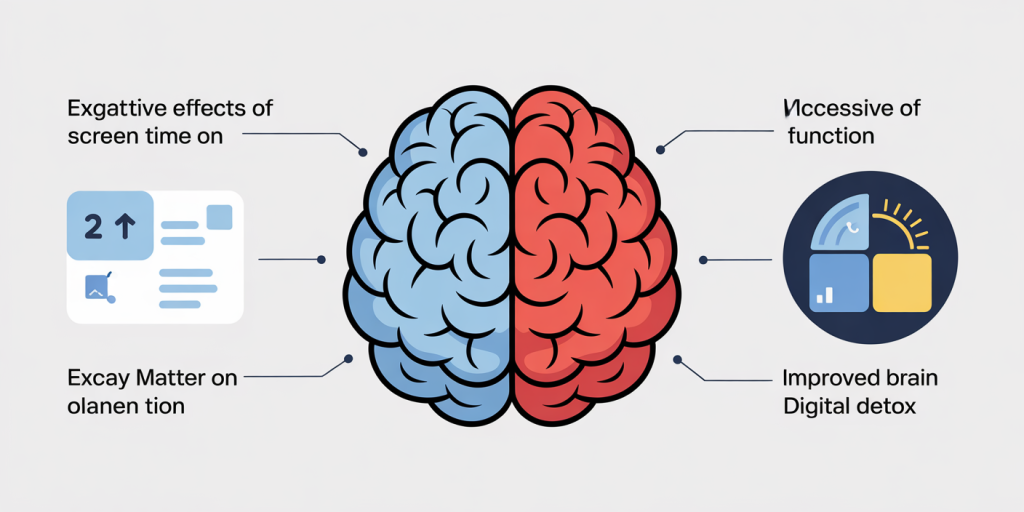How to Do a Digital Detox to Improve Focus and Mental Clarity
In today’s hyperconnected world, the persistent presence of digital devices can impair our ability to concentrate and disrupt mental well-being. Smartphones, social media platforms, emails, and streaming services keep us perpetually engaged, often leading to cognitive overload, stress, and decreased productivity. According to a 2023 report by Pew Research Center, the average adult spends nearly 7 hours per day on digital media, a significant increase from previous years. This continuous exposure to screens has been linked with reduced attention spans and cognitive fatigue, highlighting the urgent need for digital detox strategies.

A digital detox involves refraining from using electronic devices such as smartphones, tablets, computers, and social media, for a set period to reduce stress, enhance focus, and achieve mental clarity. This practice can help reset neural pathways disturbed by constant notifications and multitasking, fostering improved cognitive function and emotional balance. In this article, we explore the process of conducting a successful digital detox, practical steps to follow, and evidence-based benefits that support these efforts.
—
The Science Behind Digital Overload and Cognitive Decline
Modern neuroscience reveals how chronic digital device use impacts brain function. Studies in the Journal of Neuropsychology indicate that excessive screen time reduces the brain’s gray matter density in regions responsible for attention and decision-making. Moreover, constant multitasking encouraged by digital platforms decreases productivity by up to 40%, according to cognitive psychologist Dr. David Meyer’s research.

Beyond structural changes, digital overload fuels a state called “continuous partial attention,” where the brain is constantly scanning for new stimuli but never fully concentrating. This scattered attention diminishes deep work—the ability to focus uninterruptedly on cognitively demanding tasks, which Cal Newport emphasizes in his book *Deep Work* as essential for mastering complex skills.
Wasteful digital multitasking not only hampers productivity but also increases stress hormone cortisol levels. The American Psychological Association (APA) reported in 2022 that digital stress contributes to anxiety and sleep disturbances affecting nearly 45% of young adults in the U.S. The cumulative effect is decreased mental clarity and impaired executive function, underscoring the importance of intentional digital detoxes.
—
Practical Steps to Initiate Your Digital Detox
Embarking on a digital detox can seem overwhelming initially, but a structured approach fosters success. Start by defining clear goals—whether to improve work productivity, reduce anxiety, or enhance sleep quality. For example, Emma, a 28-year-old marketing manager, began her detox by setting daily phone-free times and limiting social media to 30 minutes per day, leading to noticeable gains in focus and mood.
Next, audit your digital usage by tracking screen time analytics available on Android and iOS devices. Identify high-distraction apps and set restrictions. Tools like Forest or Freedom can block access to these sites during work hours. Additionally, notify friends, family, and colleagues about your digital break to minimize interruptions and social obligations.
It is vital to replace digital usage with enriching offline activities. Emma started meditating for 10 minutes and reading physical books during her detox windows, cultivating mindfulness and cognitive restoration. Gradually increase detox periods—from a few hours to full-day or weekend detoxes—as comfort grows.
—
Managing Withdrawal and Staying Motivated
Digital detox efforts may trigger withdrawal symptoms such as boredom, irritability, or fear of missing out (FOMO). Recognizing and managing these responses is instrumental in sustaining detox adherence. The Yale University School of Medicine highlights parallels between smartphone addiction and substance withdrawal, recommending gradual reduction over abrupt cessation.
Structured routines help manage withdrawal. For instance, scheduling outdoor exercise, journaling, or engaging in social interactions face-to-face can substitute digital engagement. Case studies from a 2023 mindfulness retreat in California revealed that participants who committed to morning digital fasts experienced 30% lower anxiety scores after two weeks.
Accountability systems also reinforce commitment. Partnering with friends or joining support groups creates social motivation to persist. Utilizing progress tracking apps or journals documents improvements in mood and concentration, providing positive reinforcement. Reflecting on benefits during challenging moments diminishes relapse risk.
—
Comparative Analysis: Digital Detox Techniques and Their Effectiveness
To select an optimal detox method, it helps to compare common approaches based on duration, ease of adoption, and impact on mental clarity and focus:
| Detox Method | Typical Duration | Ease of Adoption | Impact on Focus | Impact on Mental Clarity |
|---|---|---|---|---|
| Partial Day Detoxes | 2-4 hours daily | High | Moderate | Moderate |
| Full-Day/Weekend Detox | 24-48 hours | Moderate | High | High |
| Social Media Fast | 1 week or more | Moderate | High | High |
| Technology-Free Zones | Ongoing (specific areas at home/work) | High | Moderate | Moderate |
| Digital Sabbatical | 1 week or longer | Low (requires planning) | Very High | Very High |
For example, a 2022 study published in *Computers in Human Behavior* demonstrated that participants who performed weekend digital detoxes showed a 25% improvement in working memory and a significant reduction in perceived stress compared to partial daily detox groups.
—
Practical Tips to Maintain Focus Post Detox
Digital detox is just the first step; sustaining enhanced focus and mental clarity requires ongoing digital hygiene. Establishing boundaries around device usage during work is crucial—for instance, enabling “Do Not Disturb” modes, turning off non-essential notifications, and using grayscale mode on smartphones, which reduces visual stimulation and habit-forming behavior.

Another effective practice is adopting the Pomodoro technique—working in uninterrupted 25-minute intervals followed by brief breaks—to maintain deep focus. Emma, from the earlier example, reported that combining detoxes with Pomodoro sessions doubled her productivity.
Additionally, prioritizing offline hobbies such as physical exercise, arts and crafts, or nature walks equips the brain with restorative experiences that buffer against digital distractions. Regular mindfulness meditation, proven in randomized controlled trials (RCTs) to increase brain connectivity in attention-related networks, complements these efforts by enhancing present-moment awareness.
—
Future Perspectives: The Evolution of Digital Detoxing
Looking ahead, the need for digital detoxes is likely to intensify as emerging technologies like augmented reality (AR) and virtual reality (VR) integrate deeper into daily life. While these offer exciting opportunities, they may also amplify cognitive overload and digital dependency risks. Consequently, individualized digital wellness programs are anticipated to become mainstream, supported by AI-driven personalization.
Corporate wellness initiatives are starting to include digital detox challenges, recognizing their benefits for employee productivity and mental health. According to a 2024 Gallup workforce survey, companies implementing digital wellness policies saw a 15% uptick in employee engagement, underscoring systemic changes needed to combat digital fatigue.
Technological advances may also provide “digital detox modes” embedded into devices, automatically limiting usage based on user stress levels or cognitive performance measured through biometrics. Such innovations blend technology with behavioral science to foster healthier digital habits sustainably.
In summary, as digital immersion deepens, mastering digital detox techniques becomes essential for optimizing focus and mental clarity. By integrating structured detox periods, mindful technology use, and supportive lifestyle habits, individuals and organizations can thrive amidst the digital age’s challenges. Embracing these strategies today paves the way for a balanced, healthy cognitive future.
